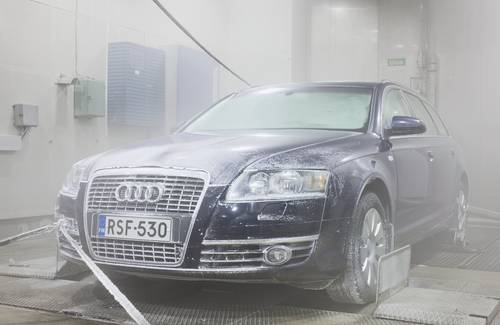Neste Oil's Engine Laboratory has tested fuels for 40 years
Neste Oil Corporation
Press Release
9 March 2015 at 10.30 a.m. (EET)
Neste Oil's Engine Laboratory has tested fuels for 40 years

Neste Oil's Engine Laboratory for fuel testing and development is now 40 years old. The Engine Laboratory locates in the Porvoo refinery area and it has ensured top quality and developed increasingly better fuels. The research work of the Engine Laboratory is unique in many respects. These kinds of tests are not performed by anyone else under Finland's cold conditions.
"Car and engine testing in the Engine Laboratory has been indispensable when Neste Oil has developed new products. The company has been a pioneer, for instance, in developing unleaded and sulfur-free fuel and decreasing exhaust emissions. The Engine Laboratory has also played an important role in the development of the renewable NEXBTL diesel. One of the most important duties of the laboratory is to ensure that the product truly works in the final use," says Lars Peter Lindfors, Senior Vice President in Technology in Neste Oil.
"The quality of fuel is easy to take for granted, but in reality it is not a trivial matter. Poor-quality diesel has stopped tens of thousands of motorists on roadsides across the world during the past few years. At the end of 2014, such problems were encountered in Sweden, for instance. When using Neste Oil's diesel, such problems do not appear," says Seppo Mikkonen, R&D Fellow at Neste Oil.
More and more is required of fuel
Engines of today are increasingly demanding.
"Fifteen years ago, fuel was injected into a diesel engine through a hole of about one millimeter at a pressure of 200 bar. Today, there are 6-8 holes with a diameter similar to the cross section of a human hair. The injection pressure has been raised to approximately 2,000 bar," says Mikkonen.
Additives that prevent wear and carbon build-up are selected for the fuels. Even small defects or errors in the additives can cause problems in new engines. This emphasizes the importance of testing.
"Fuel is a mixture containing anywhere up to thousands of hydrocarbons and ten or more products, manufactured using a precise recipe. In addition, small amounts of extra ingredients, additives, are included. Their content may only be fractions of permilles, but they have a large impact on a fuel's properties," explains Group Manager Ari Engman, the head of the Engine Laboratory.
Lower exhaust emissions
The testing operations of the Engine Laboratory continue strongly. Development programs seek to create fuels that decrease fuel consumption and emissions while improving performance.
Over the years, the Engine Laboratory has participated in numerous special projects. The laboratory has manufactured fuels for car factories' tests and Antarctic expeditions. The company's racing fuels have been used when winning world championships in speed boating and truck racing.
This is how fuels are tested
-
The test programs are taken as close to real life conditions as possible.
-
Engines representing the latest technology are run on the test benches. Some of the tests concentrate on the fuel feed system, such as injection nozzles.
-
One important tool is the dynamometer room where a car can be driven in place under varying conditions. Temperature can be adjusted from a sub zero -35 degrees to a heat of +40 degrees centigrade. Air humidity can also be varied, and the speed of the car and the airflow can be raised to 250 kilometers per hour.
-
However, the final tests are always driven with real cars among actual traffic.
Neste Oil Corporation
Kaisa Lipponen
Director, Corporate Communications
Further information: Ari Engman, Head of the Engine Laboratory, tel. +358 (0)10 458 3727
Neste Oil in brief
Neste Oil Corporation is a refining and marketing company specializing in high-quality fuels for cleaner traffic. The company produces all of the most important oil products and is the world's leading supplier of diesels made from renewable raw materials. In 2014, the company's net sales stood at EUR 15 billion, and it employs some 5,000 people. Neste Oil's shares are traded on NASDAQ Helsinki Ltd.
Neste Oil has been accepted into the Dow Jones Sustainability World Index. The company has also been on the Global 100 list of sustainable companies for several years in succession. CDP Forest has selected Neste Oil as one of the best companies in taking care of their forest footprint in the oil and gas industry. www.nesteoil.fi